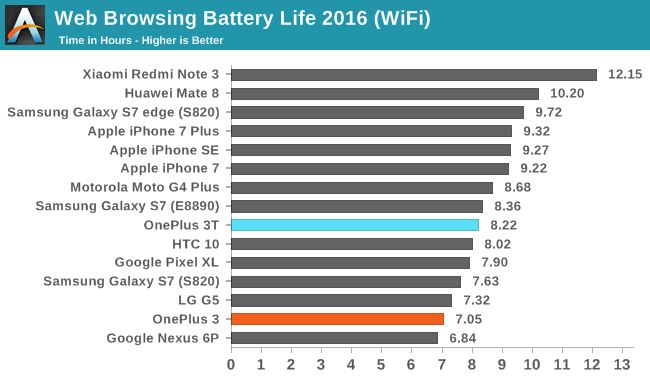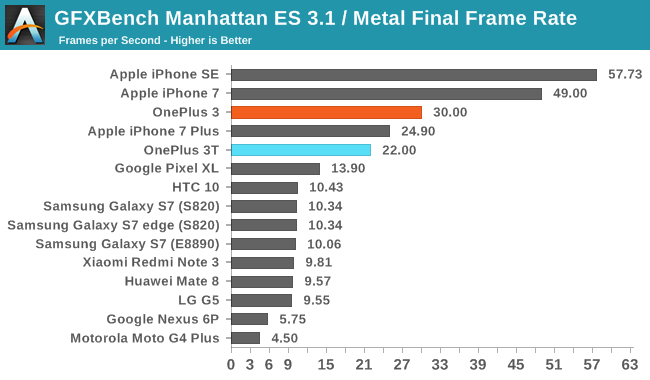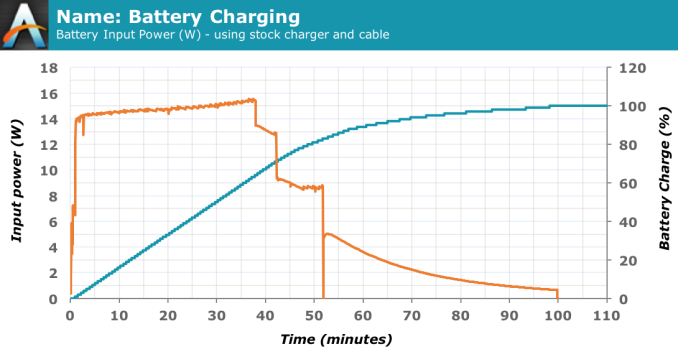The OnePlus 3T Review
by Brandon Chester on November 28, 2016 10:30 AM EST- Posted in
- Smartphones
- OnePlus
- OnePlus 3T
Battery Life
The OnePlus 3T has the same dimensions and mass as the OnePlus 3, but one of the internal changes is an increase in the battery capacity from 3000mAh to 3400mAh courtesy of improvements in battery density. This represents a capacity increase of slightly over 13%, and given that the OnePlus 3T has essentially the same hardware platform as the OnePlus 3 one can expect to see a corresponding increase in battery life due to the capacity increase alone. Any improvements in SoC efficiency and energy optimizations in the software could lead to even further improvements.
To examine the degree of improvement in battery life that the OnePlus 3T brings to the table I've run our standard set of battery benchmarks, which includes our web browsing battery test, and PCMark battery.

In our web browsing battery test the OnePlus 3T lasts 16% longer than the OnePlus 3, which is slightly longer than you'd get by simply scaling to match the 13% increase in battery capacity. Of course, there's always a degree of variance, along with differences in power usage for different SoCs and different bins of the same SoC, and these factors play a role in the outcome of the test. In any case, the increase in battery capacity comes without an increase in mass or size, so it's really just an extra hour or so of web browsing without compromising any other parts of the phone.

PCMark's battery life test runs through the same mix of tasks that emulate what users actually do with a device, so it provides a good idea of how much active usage a user can expect from a device. In this test the OnePlus 3T lasts 10% longer than the OnePlus 3, which is in line with the expected improvement from the increased battery capacity when you factor in slight differences in device platform power and test variance. This increase brings the OnePlus 3T slightly ahead of Samsung's Galaxy S7 Edge, which is a good improvement when one considers that the OnePlus 3 was beaten by the significantly smaller Exynos version of the Galaxy S7.


GFXBench demonstrates that the throttling behavior for the GPU has been changed either with the OnePlus 3T or in a newer version of OxygenOS than was available when I reviewed the OnePlus 3. I plan to re-run this test on the OnePlus 3 when OxygenOS 3.5.1 is made available for it to see if the behavior has changed. Essentially, the phone now exhibits more throttling during the test. The OnePlus 3 dropped down to a nearly constant 30fps in the Manhattan battery test, which meant if it were a real game you'd have a playable frame rate. The OnePlus 3T doesn't do as well. It drops from its peak of 33fps down to 26fps within the first twenty minutes, and slightly past forty minutes into the test it begins to oscillate rapidly between 22fps and 25-26fps.
This behavior leads to a substantial increase in battery life, but comes at the cost of performance. If this were a real game, the performance would not be sufficient on the OnePlus 3T during its 3.5 hours of battery life, while the OnePlus 3 will have lasted only 2.15 hours but maintained a sufficient frame rate for the entirety of the session.
Charge Time
Recently we have run into issues with charge time testing due to new restri ctions introduced in Android Nougat. To get around these I developed an app that we will use internally for measuring charge time. This app uses the same data set as our previous methodology, but accesses it using Android's system APIs rather than by polling the files on the disk directly. This means the results are directly comparable to ones obtained in the past, and the methodology should continue to work for the foreseeable future assuming the device's manufacturer hasn't broken the API, which unfortunately has been the case on some devices that we've tested internally.
The OnePlus 3T still ships with Android Marshmallow, so the old method of battery life testing could still be applied. However, I felt that this would be a good time to get the ball rolling with our new testing app, and I just wanted to make it clear to interested readers that we have a solution in place so we do not again encounter the issues with testing this that we did when reviewing the Pixel XL.

As expected, the OnePlus 3T takes longer to charge than the OnePlus 3, with the increase being strongly correlated to the amount that the capacity of the battery has increased. Dash Charge is still incredibly quick though, so I don't think users will have any complaints about the phone taking too long to charge. The only downside is that Dash Charge being exclusive to OnePlus means that you can only charge quickly using OnePlus's special charger and cable. I think most users end up using the block provided with their phone, but it does mean that you won't get fast charging speeds when borrowing someone else's charger, and if you end up having to buy another you can't buy a charger that supports USB Power Delivery or Qualcomm Quick Charge and utilize fast charging.












104 Comments
View All Comments
arayoflight - Tuesday, November 29, 2016 - link
Do you have any proof it's using UFS 2.1. Looks like regular UFS 2.0 with F2FS filesystem to me.To confirm that, I installed androbench on my Oneplus 3, set the parameters to what Anandtech uses(256 KB read for seq, 4KB for random and 1 I/O thread).
Since my Oneplus 3 is running on F2FS too(OxygenOS 3.5.6 has it by default)
Here are the results I got:
Random Read: 21.35 MB/s
Random Write: 25.21 MB/s
Seq read: 264.23 MB/s
Seq write: 140.4 MB/s
These are almost exactly equal to the results from the 3T in the review. Hence, I think they are not using UFS 2.1 on the 3T.
Meteor2 - Tuesday, November 29, 2016 - link
Indeed, I see no suggestion that UFS 2.1 is being used in the 3T.andrewaggb - Monday, November 28, 2016 - link
My top 3 for a smartphone are screen, cameras, battery life. This upgrade improves on 2 of them.mgl888 - Monday, November 28, 2016 - link
I wish the review tested the new front facing camera.boeush - Monday, November 28, 2016 - link
I agree with Brandon on the camera aspect: it would have been valuable to upgrade the rear camera; the front camera upgrade isn't really worth the money if the older model was already good-enough.Mr Perfect - Monday, November 28, 2016 - link
OnePlus gets a lot of love these days. I'd consider one, but the OS updating is a little hazy. What are the community builds people talk about? Does OnePlus make a release version, then open source it to the community to maintain? Are they talking about Nougat in any way?I was hoping they'd become the new Nexus, but it looks like they're not there yet.
JoeyJoJo123 - Monday, November 28, 2016 - link
CyanogenMod supports OnePlus phones, and I'm sure OnePlus 3T will come very soon.If it's any reconciliation, my Nexus 4 is on CyanogenMod 13 (Android 6.0 - Marshmallow) even though Google chose to end support for the Nexus 4 before Marshmallow even came to the Nexus 4.
JoeyJoJo123 - Monday, November 28, 2016 - link
Additionally:https://en.wikipedia.org/wiki/CyanogenMod#Cyanogen...
"The first experimental build of Cyanogenmod 14.1 based on Android 7.1 was released for Oneplus 3 device..."
So even though OnePlus themselves haven't released a Nougat equivalent of OxygenOS, yet, CyanogenMod's been on the ball, and even sourced their newest OS to the OnePlus 3 first.
There's really 3 major brands of phones that Cyanogenmod tends to support well today: Motorola, Samsung, and LG. Of those, only Motorola sometimes comes with an unlocked bootloader and root access. OnePlus phones come with that standard, as is usual with Nexus phones.
In many ways, OnePlus supplanted the Nexus line. Alternatively there's a few Motorola phones that come with unlocked bootloaders (and are marketed as Developer editions), etc.
Mr Perfect - Monday, November 28, 2016 - link
Good info, thanks. I was hoping OnePlus would be an all-in-one hardware and software solution like Nexus was, but throwing CyanogenMod on solid hardware is the next best thing.UtilityMax - Wednesday, November 30, 2016 - link
I don't get the obsession about frequent updates. To my humble eye, Lollipop, Marshmallow, and Nougat look almost the same. Nougat barely adds anything new, and Marshmallow was viewed as a bug-fix release to Lollipop. The Nexus device users were the first one to receive Nougat, but the sad reality is that Google is using them as beta testers.Regarding, Oneplus updates, based on my experience with Oneplus One, I think Oneplus updates were pretty honest. The device came out with KitKat, then got updated to Lollipop (after a lengthy delay), and then to Marshmallow. Not bad for a device that shipped with KitKat. My Samsung tablet got the same treatment, but a lot slower than Oneplus One.